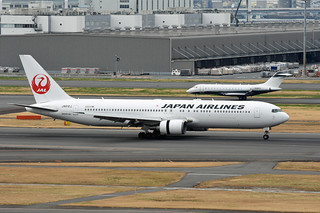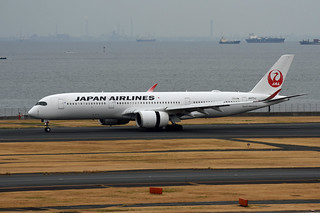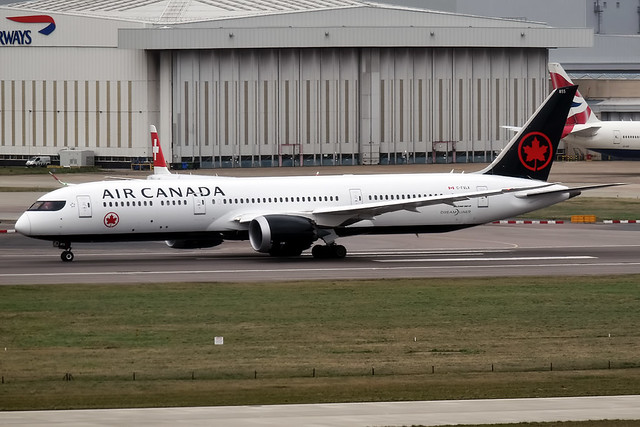JAL B772 at Tokyo on Mar 31st 2012, tail strike on go around
Last Update: December 30, 2014 / 18:33:08 GMT/Zulu time
Incident Facts
Date of incident
Mar 31, 2012
Airline
JAL Japan Airlines
Aircraft Registration
JA701J
Aircraft Type
Boeing 777-200
ICAO Type Designator
B772
In this accident, it is highly probable that the Aircraft continued rolling with the pitch-up attitude after touchdown, causing the aft fuselage to come into contact with the runway and be damaged.
It is highly probable that the Aircraft continued rolling with the pitch-up attitude due to the following reasons: after touchdown, the PIC had felt that the Aircraft had bounced to the extent necessary for go-around, and judged to make go-around to avoid a hard landing; even after he became aware that the reverse thrust levers had been raised, he continued go-around; hence, it took time for the engine thrust to increase and he continued to pull his control column. Moreover, it is somewhat likely that, in a situation in which the PIC had been assisting the control of the FO, and without the PIC’s declaring a takeover, the intention of the PIC was not properly conveyed to the FO, the sharing of duties between PF and PM became momentarily unclear, and the monitoring of flight information such as pitch angle and speed, which was the duty of PM, was not performed adequately.
The JTSB reported that the captain (42, ATPL, 6,848 hours total, 3,754 hours on type) was pilot monitoring, the first officer (29, CPL, 1,810 hours total, 1,506 hours on type) was pilot flying. The aircraft was on final approach to Haneda's runway 34L when tower reported the winds from 020 degrees at 17 knots and issued landing clearance, subsequently adding that previous landing traffic had reported a windshear of 25 knots at 800 feet AGL. The crew configured the flaps to 25 degrees. While descending between 1670 feet and 650 feet the wind changed from 210 degrees at 5 knots clockwise to 70 degrees at 10 knots, then to 240 degrees counterclockwise at 5 knots and finally to 010 degrees clockwise at 13 knots.
The autopilot was disconnected while descending through 334 feet AGL, the aircraft crossed the runway threshold at 41 feet AGL at 152 KIAS. Shortly after the automated "Fifty" Call the first officer applied back pressure on the control column. The right main gear made contact with the runway surface, the speedbrake lever extended and the spoilers began to deploy, the thrust levers were pulled to idle. The first officer applied back pressure on his control column, the captain began to apply down pressure on his control column, the airspeed was 145 KIAS, the pitch angle +3.3 degrees, roll angle 2.1 degrees to the right, vertical acceleration was +1.27G, the right main gear touched down 610 meters past the runway threshold. A second later the left main gear touched down and unloaded again, the thrust reversers were commanded open, the captain's control column was now pulled back, airspeed 144 KIAS, pitch angle +1.8 degrees, roll angle 0.7 degrees to the right. The vertical acceleration fluctuated twice between +0.52G and +1.62G, the captain pushed the control column forward and commanded "Go Around! Go Around!" The left landing gear indicated on the ground again, the brakes pressure began to increase, the aircraft was 760 meters past the runway threshold, 142 KIAS and +2.5 degrees pitch. The captain called "Go Around" again and applied back pressure on his control column while the first officer relinquished pressure on the control column. The pitch angle increased to +10.4 degrees at 130 KIAS. The first officer called "flaps 20", by that time all spoilers reached their fully extended positions. The reversers were commanded closed again and the thrust levers were moved forward, the brakes pressure began to decrease, the speed brake lever was retracted and the spoilers began to retract 1370 meters past the runway threshold at 108 KIAS. 1710 meters past the runway threshold, at 105 KIAS and 11 degrees nose up, a Tail Strike Caution was issued, the engines began to accelerate. The first officer call "I'll set flaps 20", the commander called "I have control", the flaps lever was set to 20 degrees, the first officer called "you have control", the airspeed reached its minimum at 100 KIAS and the pitch reached its maximum of 13.5 degrees nose up. The airspeed increased to 116 knots about 2130 meters past the runway threshold and both gear struts indicated airborne, 4 seconds later the first officer called "positive rate" , the gear was retracted and the aircraft climbed out. The first officer radioed tower that a tail strike had occurred.
The JTSB reported that the tail would touch the runway surface with a pitch attitude of 10.2 degrees with the main gear legs compressed and at 12.1 degrees with the main gear legs uncompressed.
The JTSB analysed that the aircraft had descended relatively stable through the windshear, after clear of the windshear the first officer disconnected the autopilot, the approach was stabilized.
The JTSB analysed: "when the FO pulled on the control column and initiated flare six seconds before the right main landing gear touched down at 16:07:58, the PIC had already started control. After touchdown, in correspondence to the PIC’s large operation of his control column, the FO side column force had decreased. Moreover ... the FO stated that he controlled aircraft up to touchdown according to his own plans, and felt that the touchdown went smoothly. The PIC stated that, during approach, he put his right hand on the lower part of the thrust levers, and his left hand on the control column, and before touchdown, he judged that it was time to retard the thrust levers, and gradually retarded it. From these points, it is highly probable that the FO had been assisted with controls by the PIC from around the time when he initiated flare."
The JTSB continued: "after the right main landing gear touched the ground, the PIC operated his control column in a large way toward the pitch-up and pitch-down directions to assist the control of the FO, and the vertical acceleration of the Aircraft fluctuated significantly twice. Moreover ... the PIC felt a sinking sensation, and the Aircraft floating again after touchdown again, and realized that it was continuing to float in mid-air. It is probable that due to the changes in vertical acceleration that occurred after touchdown, the PIC had felt that the Aircraft had bounced and was floating. However ... it is probable that although the shock absorber of the left main landing gear became compressed and extended momentarily, a bounce that would lead to the main landing gears moving away from the runway did not occur. Moreover, it is probable that the significant changes in the vertical acceleration had occurred due to the PIC having operated the control column in a large way."
The JTSB analysed further: "when both main landing gears touched the ground at 16:08:05, the thrust levers were in the interlock position ... the FO stated that as he felt touchdown and heard the sound of touchdown, he raised the reverse thrust levers to the interlock position. Based on this, it is highly probable that the FO was aware of touchdown, and had raised the reverse thrust levers. On the other hand ... the PIC stated that since the thrust levers could not be advanced forward, he turned his sight to the thrust levers and noticed that the reverse thrust levers had been raised to the interlock position. Based on this, it is probable that ... the PIC had diverted his attention to look outside of the Aircraft to confirm its attitude; therefore, he was not aware of the reverse thrust levers raised by the FO. ... the PIC had felt the Aircraft had bounced and was floating ... he stated that he judged that the next touchdown was going to become hard; accordingly, he called for go-around. Based on this, it is highly probable that ... the PIC had felt that the Aircraft had bounced to the extent necessary for go-around, and then judged to make go-around to avoid a hard landing. ... it is stated in the AOM that once reverse thrust is initiated, a full stop landing must be made. However ... the PIC was not aware of the reverse thrust levers raised by the FO. Assuming that the PIC (as PM) had monitored the levers raised by the FO (as PF), or had been informed of raising of the levers by the FO, it is somewhat likely that the PIC would not have made go-around. However, the PIC had continued with the go-around even after he had noticed that the reverse thrust levers had been initiated. Since go-around after reverse operation incurs several risk items ..., the flight crew should be well aware of the fact that the AOM states that once reverse thrust levers are initiated, a full stop landing must be made. ... the PIC judged to make go-around to avoid a hard landing and ordered the FO to do it. However, at this time, the PIC had diverted his attention to look outside of the Aircraft to confirm its attitude, and as he was calling out for go-around several times during a short time period, it is probable that the PIC ordered under heavily stressed conditions. ... it is highly probable that the PIC had ordered the FO to make go-around, but the FO had not advanced the thrust levers forward; consequently, he initiated a takeover. Moreover ... the PIC had diverted his attention to confirm the attitude of the Aircraft, and ordered to make go-around under heavily stressed conditions. However ... it was sixteen seconds after the go-around call, at two seconds after the
tail strike when the PIC called “I have control” and took over controls."
The JTSB concluded analysis: "... it is probable that the FO had judged that he had continued to be assisted with control by the PIC after the call for go-around, and while entrusting controls to the PIC, he had continued his duty as PF until the PIC called out for takeover. ... it is somewhat likely that, in a situation in which the PIC had been assisting the control of the FO, and without the PIC’s declaring a takeover, the intention of the PIC was not properly conveyed to the FO, the sharing of duties between PF and PM became momentarily unclear, and the monitoring of flight information such as pitch angle and speed, which was the duty of PM was not performed adequately."
Incident Facts
Date of incident
Mar 31, 2012
Airline
JAL Japan Airlines
Aircraft Registration
JA701J
Aircraft Type
Boeing 777-200
ICAO Type Designator
B772
This article is published under license from Avherald.com. © of text by Avherald.com.
Article source
You can read 2 more free articles without a subscription.
Subscribe now and continue reading without any limits!
Read unlimited articles and receive our daily update briefing. Gain better insights into what is happening in commercial aviation safety.
Send tip
Support AeroInside by sending a small tip amount.
Related articles
JAL B789 over Pacific Ocean on Dec 22nd 2025, turbulence injures flight attendant
A JAL Japan Airlines Boeing 787-9, registration JA865J performing flight JL-57 (dep Dec 21st 2025) from San Francisco,CA (USA) to Tokyo Narita…
JAL B788 at Sapporo on Dec 9th 2025, hydraulic failure
A JAL Japan Airlines Boeing 787-8, registration JA847J performing flight JL-516 from Sapporo Chitose to Tokyo Haneda (Japan) with 294 people on…
JAL B763 at Kagoshima on Nov 14th 2025, bird strike
A JAL Japan Airlines Boeing 767-300, registration JA612J performing flight JL-646 from Kagoshima to Tokyo Haneda (Japan) with 258 people on board,…
JAL A359 near Sapporo on Sep 4th 2025, engine shut down in flight
A JAL Japan Airlines Airbus A350-900, registration JA07XJ performing flight JL-500 from Sapporo Chitose to Tokyo Haneda (Japan) with 285 people on…
JAL B789 near Seoul on Sep 4th 2024, turbulence injures flight attendant
A JAL Japan Airlines Boeing 787-9, registration JA863J performing flight JL-22 from Beijing (China) to Tokyo Haneda (Japan) with 121 passengers and…
Newest articles
EAT Leipzig A306 at Brussels on Nov 26th 2020, rejected takeoff above V1 due to difficulties becoming airborne
An EAT Leipzig Airbus A300-600 freighter on behalf of DHL, registration D-AEAI performing flight QY-841 from Brussels (Belgium) to Vitoria,SP…
Canada B789 at Auckland on Jan 13th 2026, unusual odour
An Air Canada Boeing 787-9, registration C-FVLX performing flight AC-40 from Auckland (New Zealand) to Vancouver,BC (Canada) with 269 passengers and…
Subscribe today
Are you researching aviation incidents? Get access to AeroInside Insights, unlimited read access and receive the daily newsletter.
Pick your plan and subscribePartner

ELITE Simulation Solutions is a leading global provider of Flight Simulation Training Devices, IFR training software as well as flight controls and related services. Find out more.
SafetyScan Pro provides streamlined access to thousands of aviation accident reports. Tailored for your safety management efforts. Book your demo today
AeroInside Blog
Popular aircraft
Airbus A320Boeing 737-800
Boeing 737-800 MAX
Popular airlines
American AirlinesUnited
Delta
Air Canada
Lufthansa
British Airways







